A Brief Introduction to Printmaking
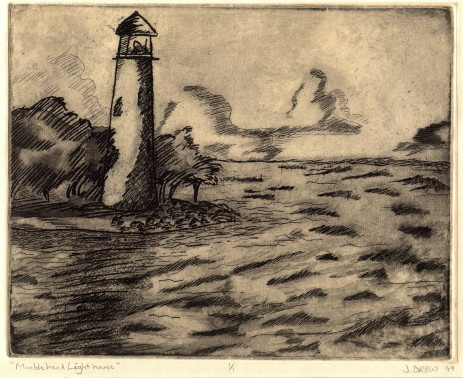
Printmaking is one of the many media an artist can work with. The art of printmaking evolved from the desire to make reproductions of manuscripts and artwork. Using presses and woodblocks, printers mass-produced books in some of the first commercial art endeavors. Today, book-printing and other commercial mass-production is automated, and old printmaking techniques are now outdated.
Printmakers use a variety of techniques to produce artworks. Among these techniques are Relief Printing, Intaglio, and Lithography.
The oldest western technique is Relief Printing. Usually, wood or linoleum blocks are used in relief printing. The surface of the block is carved away. That which is carved away will appear white in the final print. The original surface will appear black or in color. Ink is spread over the
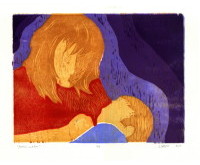 surface of the block, using a roller. A sheet of paper is laid over the block, and the block and the paper are sent through the press. The pressure transfers the ink from the block to the paper.
surface of the block, using a roller. A sheet of paper is laid over the block, and the block and the paper are sent through the press. The pressure transfers the ink from the block to the paper.
Wood blocks are also used in Japanese Printing. Japanese printing does not use a traditional printing press. The wood block can be inked up with ink, watercolors, or another kind of paint. A thin japanese style paper is laid over the "charged", or inked, block. Then, a Baren, a tool which consists of a flat surface with a handle, is used to press the paper into the block. The ink is transfered through hand-power.
Multi-color relief prints can be created using many different techniques. One way is to create multiple blocks, each one meant to print a different color. Another method is called Reductive Wood Block Printing. With this technique the artist begins with a wood block with little or none of the surface carved away. The artist prints this, using a light color. The artist then carves away more of the surface and prints it again over the previous color, using a different color. The artist "reduces" the surface until they reach the final print. The above woodcut, Mother and Son is an example of a reductive wood block.
For examples of relief prints, look at The Apocalypse by Albrecht Durer.
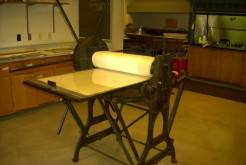 Intaglio is a process of printing with metal plates. Traditionally, copper or zinc plates are used. In intaglio, the recessed areas of the plate are what prints. Ink is spread over the entire plate. The ink is wiped away from the surface and forced into the recessed areas. The paper is soaked in water and laid on top of the inked plate, and both are run through the press, like the one pictured. The pressure forces the damp paper down into the ink-filled recesses of the plate, transferring the ink to the paper. The paper is left to dry.
Intaglio is a process of printing with metal plates. Traditionally, copper or zinc plates are used. In intaglio, the recessed areas of the plate are what prints. Ink is spread over the entire plate. The ink is wiped away from the surface and forced into the recessed areas. The paper is soaked in water and laid on top of the inked plate, and both are run through the press, like the one pictured. The pressure forces the damp paper down into the ink-filled recesses of the plate, transferring the ink to the paper. The paper is left to dry.
There are several techniques used to process plates for intaglio. When Etching, acid is used to eat away the metal plate to create recessed areas. Acid booths, like the ones seen in the picture, can be used to protect the artist and others from the fumes of the acid. Some form of acid resist is used to save areas from being
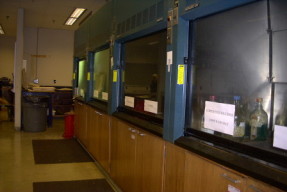 bitten by the acid. This resist can take many forms depending on the desired effect. Another intaglio processing technique is called Dry-point. Dry Point doesnt use acid and is traditionally only used on copper plates. A sharp metal needle is used to scratch lines into the surface of the plate. This creates a burr, which holds ink as well as the line. Many other tools can be used to alter up a plate, such as burnishers (metal-working tools which smooth the surface), sand paper, charcoal, or chalk.
bitten by the acid. This resist can take many forms depending on the desired effect. Another intaglio processing technique is called Dry-point. Dry Point doesnt use acid and is traditionally only used on copper plates. A sharp metal needle is used to scratch lines into the surface of the plate. This creates a burr, which holds ink as well as the line. Many other tools can be used to alter up a plate, such as burnishers (metal-working tools which smooth the surface), sand paper, charcoal, or chalk.
Multi-color intalglio prints can be created in a variety of ways. One technique is to use multiple plates, each devoted to a different color. Another method is to ink up a plate with one color and roll another color onto the surface. Another technique, called A' la Poupe' involves wiping different areas of the plate with different colors. Colors can be blended in this method.
For examples of intaglio prints, look at Albrecht Durers Adam and Eve or Melencolia I. Artists, such as Rembrandt van Rijn, also used metal plates as studies for their paintings. Pablo Picasso used a technique called lift-ground or sugar-ground to draw on his metal plates for intaglio.
Lithography, invented by Aloys Senefelder in 1796, is based on the natural separation of oil and water. A flat stone or aluminum plate can be used for this process, but unlike the other techniques above, the stone or plate is not changed at all during the process. The artist draws on the stone
with an oil-based crayon, or similar tool. Through a chemical process, the oil is replaced with ink. The ink is then transferred to paper through a press, like the one shown below:
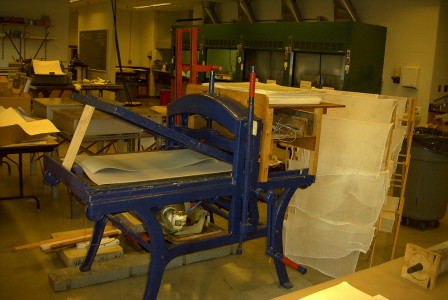
A variety of drawing tools can be used to create different effects. Oil-based crayons, or grease pencils, of verying degrees of oil are used to draw and can produce an effect not unlike pencils or charcoal on paper. Pure grease can be used to fill in large areas. Liquid tush, a mixture of grease and water, can be used to paint areas, producing a watercolor effect. Lithography is thought to be one of the most difficult to master of the printmaking techniques.
For examples of lithographs, look at the posters and prints of Henri de Toulouse-Lautrec.
Here is one of my lithographs:
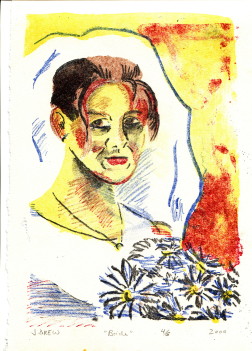
Part of the Angelworks project was to create fine art pieces with the pen and ink pages of the comic book form. The layout of the comic book pages is used as a starting point for the composition of the print.
My hope is that the viewer will understand that comic books are another form of fine art, related to sculpture and painting. Comic books can have the strength of design, strong themes, and beauty of the other media.
This piece is a copper etching, drawing from the layout of Page 7 of Angelworks (seen to the right).
FIRST STATE
SECOND STATE
THIRD STATE
FOURTH STATE
Check out more of my work in my WEB GALLERY...
written by Jeremy Drew...
HOME
 bitten by the acid. This resist can take many forms depending on the desired effect. Another intaglio processing technique is called Dry-point. Dry Point doesnt use acid and is traditionally only used on copper plates. A sharp metal needle is used to scratch lines into the surface of the plate. This creates a burr, which holds ink as well as the line. Many other tools can be used to alter up a plate, such as burnishers (metal-working tools which smooth the surface), sand paper, charcoal, or chalk.
bitten by the acid. This resist can take many forms depending on the desired effect. Another intaglio processing technique is called Dry-point. Dry Point doesnt use acid and is traditionally only used on copper plates. A sharp metal needle is used to scratch lines into the surface of the plate. This creates a burr, which holds ink as well as the line. Many other tools can be used to alter up a plate, such as burnishers (metal-working tools which smooth the surface), sand paper, charcoal, or chalk.
 surface of the block, using a roller. A sheet of paper is laid over the block, and the block and the paper are sent through the press. The pressure transfers the ink from the block to the paper.
surface of the block, using a roller. A sheet of paper is laid over the block, and the block and the paper are sent through the press. The pressure transfers the ink from the block to the paper.
 Intaglio is a process of printing with metal plates. Traditionally, copper or zinc plates are used. In intaglio, the recessed areas of the plate are what prints. Ink is spread over the entire plate. The ink is wiped away from the surface and forced into the recessed areas. The paper is soaked in water and laid on top of the inked plate, and both are run through the press, like the one pictured. The pressure forces the damp paper down into the ink-filled recesses of the plate, transferring the ink to the paper. The paper is left to dry.
Intaglio is a process of printing with metal plates. Traditionally, copper or zinc plates are used. In intaglio, the recessed areas of the plate are what prints. Ink is spread over the entire plate. The ink is wiped away from the surface and forced into the recessed areas. The paper is soaked in water and laid on top of the inked plate, and both are run through the press, like the one pictured. The pressure forces the damp paper down into the ink-filled recesses of the plate, transferring the ink to the paper. The paper is left to dry.
